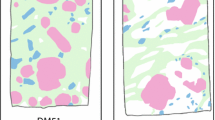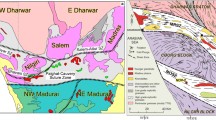Abstract
Retrograde interdiffusion is widely proposed as the dominant factor in producing the stable isotopic fractionation among minerals in slowly cooled igneous and metamorphic rocks. Mineral zonation consistent with interdiffusion of stable isotopes has never been directly observed, however, leaving doubt as to the mechanism responsible for the bulk-mineral isotopic compositions commonly measured. Ion microprobe analyses of oxygen isotope ratios in magnetite were combined with conventional bulk mineral analyses and diffusion modeling to document the relationship between mineral zonation and the mechanism of retrogression inferred from bulk mineral data. Two samples of magnetitebearing, quartzo-feldspathic Lyon Mountain gneiss from the Adirondack mountains, N.Y. were studied in detail. Conventional stable isotope analysis of both samples indicates that isotope thermometers are discordant and were reset by as much as 200°C from the estimated peak temperature of 750°C. The relative order of apparent temperatures recorded by various thermometers differs between the two samples, however, with T qtz-fsp≫T mt-qtz and T mt-fsp in one sample and T qtz-fsp<T mt-qtz and T mt-fsp in the other. Diffusion modeling using the Fast Grain Boundary model shows that the former pattern of apparent temperatures is consistent with closed system interdiffusion during cooling, whereas the latter is not. The modeling predicts that 0.5 mm diameter magnetite grains common to this rock type will contain isotopic zonation of 1‰ (rims lower in δ18O than cores), and that the cores of smaller (0.1 mm) grains will be similarly lower than to the cores of large (0.5 mm) grains. Ion microprobe analysis reveals that the zoning patterns of magnetite grains from the first sample contain clear core to rim zonation in multiple grains (Δcore-rim=1.1±0.4‰) and predicted grain-size vs core composition variations, consistent with diffusion-controlled resetting of bulk mineral fractionations. In contrast, the second sample shows irregular inter-and intra-granular variations over an 8‰ range, consistent with open system alteration. These results provide direct documentation of the importance of interdiffusion in affecting stable isotope distributions in slowly cooled rocks. The correlations of bulk-mineral resetting with zonation show that bulk mineral data, when interpreted with detailed modeling, can be used to determinate what processes controlling retrogression.
Similar content being viewed by others
References
Becker RH (1971) Carbon and oxygen isotope ratios in iron-formation and associated rocks from the Hamersley Range of Western Australia and their implications. PhD thesis, Chicago Univ
Bohlen SR (1987) Pressure-temperature-time paths and a tectonic model for the evolution of granulites. J Geol 95:617–632
Bohlen SR, Valley JW, Essene EJ (1985) Metamorphism in the Adirondacks. I. petrology, pressure and temperature. J Petrol 26:971–992
Bohlen SR, McLelland J, Valley J, Chiarenzelli J (1992) Petrology and geochronology of the Adirondack Mountains: a critical look at a classic granulite terrain and its associated anorthosite-mangerite-charnockite-granite (AMCG) suite. Field guide for IGCP-304
Cartwright I, Valley JW, Hazelwood A (1993) Resetting of oxybarometers and oxygen isotope ratios in granulite facies orthogneneisses during cooling and shearing, Adirondack Mountains, New York. Contrib Mineral Petrol 113:208–225
Chamberlain CP, Conrad ME (1991) Oxygen isotope zoning in garnet. Science 254:403–406
Chiba H, Chacko T, Clayton RN, Goldsmith JR (1989) Oxygen isotope fractionations involving diopside, forsterite, magnetite and calcite: application to geothermometry. Geochim Cosmochim Acta 53:2985–2995
Clayton RN, Mayeda TK (1963) The use of bromine pentafluoride in the extraction of oxygen from the oxides and silicates for isotopic analysis. Geochim Cosmochim Acta 27:43–52
Cole DR, Ohmoto H (1986) Kinetics of isotopic exchange at elevated temperatures and pressures. In: Valley JW, Taylor HP Jr, O'Neil JR (eds) Stable isotopes in high temperature geological processes (Reviews in Mineralogy vol. 16) Mineralogical Society of America, Washington DC, pp 41–87
Cole DR, Ohmoto H, Lasaga A (1983) Isotopic exchange in mineral-fluid systems-I. Theoretical evaluation of oxygen isotope exchange accompanying surface reactions and diffusion. Geochim Cosmochim Acta 53:1681–1693
Crowe DE, Valley JW, Baker K (1990) Micro-analysis of sulfurisotope ratios and zonation by laser microprobe. Geochim Cosmochim Acta 54:2075–2092
Deines P (1977) On the oxygen isotope distribution among mineral triplets in igneous rocks. Geochim Cosmochim Acta 41:1709–1730
Dennis PF (1984) Oxygen self diffusion in quartz. Progress in Experimental Petrology. NERC Publ. D. 25:260–265
Dodson MH (1973) Closure temperature in cooling geochronologic and petrologic systems. Contrib Mineral Petrol 40:259–274
Eiler JM (1994) Diffusion of stable isotopes in metamorphic rocks: theoretical and applied studies. PhD thesis, University of Wisconsin
Filer JM, Baumgartner LP, Valley JW (1992) Interdiffusion of stable isotopes: a fast grain boundary model. Contrib Mineral Petrol 112:543–557
Eiler JM, Valley JW, Baumgartner LP (1993) A new look at stable isotope thermometry. Geochim Cosmochim Acta 57:2571–2583
Eldridge CS, Compston W, Williams IS, Walsh JL (1987) In situ microanalysis for 34S/32S ratios using the ion microprobe SHRIMP. Int J Mass Spectron Ion Process 76:65–83
Elphick SC, Graham CM (1990) Hydrothermal oxygen diffusion in diopside at 1 kb, 900 1200°C, a comparison with oxygen diffusion in forsterite, and constraints on oxygen isotope disequilibrium in peridotite nodules. Terra Abstracts 2:72
Elsenheimer D, Valley JW (1993) Submillimeter scale zonation of δ18O in quartz and feldspar, Isle of Skye, Scotland. Geochim Cosmochim Acta 57:3669–3676
Farver JR (1990) Oxygen self-diffusion in diopside with application to cooling rate determinations. Earth Planet Sci Lett 92:386–396
Farver JR, Yund RA (1990) The effect of hydrogen, oxygen and water fugacity on oxygen diffusion in alkali feldspar. Geochim Cosmochim Acta 54:2953–2964
Farver JR, Yund RA (1991) Oxygen diffusion in quartz: dependence on temperature and water fugacity. Chem Geol 90:55–70
Giletti BJ (1985) The nature of oxygen transport within minerals in the presence of hydrothermal water and the role of diffusion. Chem Geol 53:197–206
Giletti BJ (1986) Diffusion effects on oxygen isotope temperatures of slowly cooled igneous and metamorphic rocks. Earth Planet Sci Lett 77:218–228
Giletti BJ, Hess KC (1988) Oxygen diffusion in magnetite. Earth Planet Sci Lett 89:115–122
Giletti BJ, Shimizu N (1989) Use of the ion microprobe to measure natural abundances of oxygen isotopes in minerals. US Geol Surv Bull 1890:129–136
Giletti BJ, Semet MP, Yund RA (1978) Studies in diffusion III. Oxygen in feldspars, an ion microprobe determination. Geochim Cosmochim Acta 42:45–57
Hervig RL, Thomas RM, Williams P (1989) Charge neutralization and oxygen isotopic analysis of insulators with the ion microprobe. US Geol Surv Bull 1890:137–143
Javoy M (1977) Stable isotopes and geothermometry. J Geol Soc Lond 133:609–636
Kohn MJ, Valley JW, Elsenheimer D, Spicuzza M (1993) Oxygen isotope zoning in garnet and staurolite: evidence for closed system mineral growth during regional metamorphism. Am Mineral 78:988–1001
Lamb WM, Brown PE, Valley JW (1991) Fluid inclusions in Adirondack granulites: implications for the retrograde P-T path. Contrib Mineral Petrol 107:472–483
Lindsley DH (1976) Experimental studies of oxide minerals. In: Rumble DH III (ed) Oxide minerals (Reviews in Mineralogy vol. 3). Mineralogical Society of America, Washington DC, pp 61–88
Lindsley DH (1991) Experimental studies of oxide minerals. In: Lindsley DH (ed) Oxide minerals: petrologic and magnetic significance (Reviews in Mineralogy vol. 25). Mineralogical Society of America, Washington DC, pp 69–106
Lindsley DH, Lindh A (1974) A hydrothermal investigation of the system FeO−Fe2O3−TiO2: a discussion with new data. Lithos 7:65–68
Lorin JC, Slodzian G, Dennebouy R, Chaintreau M (1990) SIMS measurement of oxygen isotope-ratios in meteorites and primitive solar system matter. In: Benninghoven A, Evans CA, McKeegan KD, Storms HA, Werner HW (eds) Secondary ion mass spectrometry SIMS VII. Wiley Chichester, pp 377–380
McLelland JM, Chiarenzelli J (1990) Isotopic constraints on emplacement age of anorthositic rocks of the Marcy Massif, Adirondack Mts NY. J Geol 98:19–41
McLelland JM, Chiarenzelli J (1991) Geochronological studies in the Adirondack Mountains and the implications of a middle Proterozoic tonalite suite. Geol Assoc Can Spec Pap 38:175–194
McLelland JM, Chiarenzelli J, Whitney P, Isachsen Y (1988) U−Pb zircon geochronology of the Adirondack Mts. and implications for their tectonic evolution. Geol 16:920–924
Mezger K, Rawnsley C, Bohlen SR, Hanson GN (1990) U−Pb garnet, sphene, monazite, and rutile ages: implications for the duration of high-grade metamorphism and cooling histories, Adirondack Mts., New York. J Geol 99:415–428
Mielke H, Schreyer W (1972) Magnetite-rutile assemblages in metapelites of the Fichtelgebirge, Germany. Earth Planet Sci Lett 16:423–428
Morrison J, Valley JW (1988) Post-granulite facies fluid infiltration in the Adirondack Mountains. Geol 16:513–516
Morrison J, Valley JW (1991) Retrograde fluids in granulites: stable isotope evidence of fluid migration. J Geol 99:559–570
O'Neil J, Taylor HP Jr (1967) The oxygen isotope and cation exchange chemistry of feldspars. Am Mineral 52:1414–1437
O'Neil JR, Clayton RN, Mayeda TK (1969) Oxygen isotope fractionation in divalent metal carbonates. J Chem Phys 51:5547–5558
Rumble DH III (1976) Oxide minerals in metamorphic rocks. In: Rumble DH III (ed) Oxide minerals (Reviews in Mineralogy vol. 3). Mineralogical Society of America, Washington DC, pp R1-R24
Sharp ZD (1990) A laser based microanalytical method for the in situ determination of oxygen isotope ratios of silicates and oxides. Geochim Cosmochim Acta 54:1353–1357
Sharp ZD (1991) Determination of oxygen diffusion rates in magnetite from natural isotopic variations. Geology 19:653–656
Sitzman SD, Banfield JF, Valley JW (1994) Serpentine/Talc filled submicroscopic solution channels in metamorphic magnetic: an explanation for micron-scale oxygen heterogenity? Geol Soc Am abstr w pro 26:A279
Southwick DL (1968) Mineralogy of a rutile- and apatite-bearing ultra-mafic chlorite rock. US Geol Surv Prof Pap 600-C:C38–C44
Valley JW (1986) Stable isotope geochemistry of metamorphic rocks. In: Valley JW, Taylor HP Jr, O'Neil JR (eds) Stable isotopes in high temperature geologic processes (Reviews in Mineralogy vol. 16). Mineralogical Society of America, Washington DC, pp 445–490
Valley JW, Graham CM (1991) Ion microprobe analysis of oxygen isotope ratios in granulite facies magnetites: diffusive exchange as a guide to cooling history. Contrib Mineral Petrol 109:38–52
Valley JW, Graham CM (1993) Cryptic grain-scale heterogeneity of oxygen isotope ratios in metamorphic magnetite. Science 259:1729–1733
Wada H (1988) Microscale isotopic zoning in calcite and graphite crystals in marble. Nature 331:61–63
Whitney P, Olmstead J (1988) Geochemistry and origin of albite gneisses, northeastern Adirondacks, N.Y. Contrib Mineral Petrol 99:476–484
Zinner E (1989) Isotopic measurements with the ion microprobe. US Geol Surv Bull 1890:145–162
Author information
Authors and Affiliations
Rights and permissions
About this article
Cite this article
Eiler, J.M., Valley, J.W., Graham, C.M. et al. Ion microprobe evidence for the mechanisms of stable isotope retrogression in high-grade metamorphic rocks. Contr. Mineral. and Petrol. 118, 365–378 (1995). https://doi.org/10.1007/BF00461404
Received:
Accepted:
Issue Date:
DOI: https://doi.org/10.1007/BF00461404




